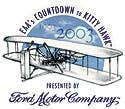
When the Wrights returned to Dayton in the fall of 1902, they immediately set to work on designing an entirely new flying machine. They called it their Flyer to distinguish it from their previous gliders, for it was indeed much more. This machine, they knew, needed a much stronger and more rigid structure to carry the weight and withstand the vibrations of propellers and its powerplant.
The Flyer first took shape in a preliminary sketch Wilbur drew on brown wrapping paper, showing the top, side and front views of the machine. It was much larger and heavier than its predecessors-seven feet high, 19 feet 9 inches in length, with a weight of 605 pounds (without pilot), sporting a 40.3-inch wingspan and over 500 square feet of total wing area. Compared to earlier, more graceful gliders, it was a rather ugly duckling, more squat and stumpy.
|| |---| | | | The Wrights' small homebuilt engine generated 16 horsepower.| The Flyer was also sturdier. The ribs were built up of two pieces of wood, tacked and glued in place over supporting blocks. The end bows were pieces of specially bent wood used in carriage building, and the Wrights covered the wings, top and bottom, with a tightly woven muslin known as "Pride of the West." It came straight off the bolt, with no additional doping to make it more airtight.
Each wing was built in three sections, with final construction to take place once they had arrived at Kitty Hawk in the fall. The two outer bays were warped, but this time the central bay, which had to support a pilot, engine and drive mechanism, was rigid by necessity. A hip cradle provided wing-warping and rudder operation, and there was a hand control for the elevator, a double-surfaced design the Wrights hoped would carry a big part of the flight load, especially in the first moments off the ground.
There were two other significant changes. Most distinguishable was the droop of the wings, which appeared too weak to support their weight, the tips being a full 10 inches lower than the central wing section. This droop was deliberate, meant to minimize wind gusts from the side. Not as noticeable was the lack of symmetry. The Flyer's right wing was four inches longer than its left. This, the Wrights realized, was needed to provide additional lift for the motor and accessories, which were 50 pounds heavier than the pilot, who lay on the left side of the central section.
The Wrights were excited, throughout the summer, as their "whopper flying machine," as Orville called it, began to take shape. This trip to Kitty Hawk, they knew, would be unlike those of the past. Before, the emphasis had been on testing new theories and verifying the results of testing done the previous winter. This time their goal was different. Success would be nothing less than getting a powered machine off the ground and sustaining and controlling its flight.
This "Kitty Hawk Moment" is brought to you by the EAA, whose Countdown to Kitty Hawk program, presented by Ford Motor Company, includes an exact flying reproduction of the Wright Flyer. It is the centerpiece of the EAA's national tour during 2003, which will conclude with a five-day celebration at Kitty Hawk, North Carolina, where the Wright Flyer will fly again at exactly 10:35 a.m. on December 17, 2003, commemorating 100 years of powered flight.
www.countdowntokittyhawk.org

Sign-up for newsletters & special offers!
Get the latest FLYING stories & special offers delivered directly to your inbox






